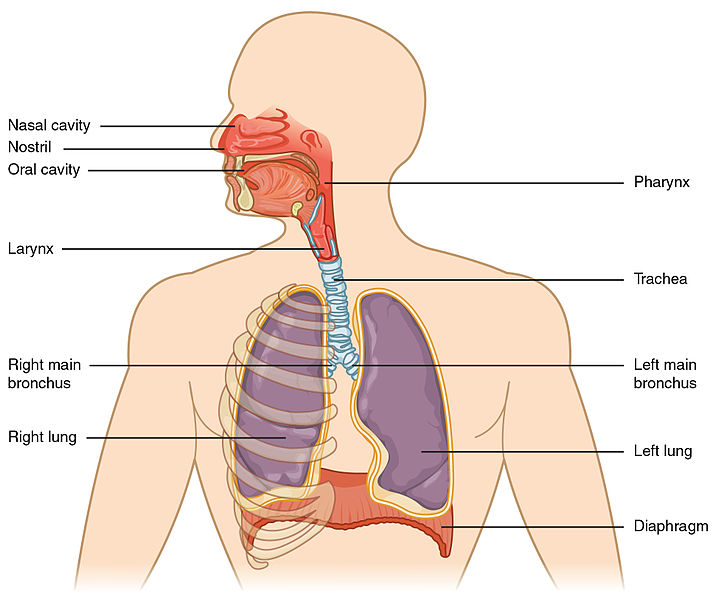15.2 Review of Anatomy & Physiology of the Respiratory System
The major parts of the respiratory system are illustrated in Figure 15.1.[1] Table 15.2 provides a high-level overview of the major parts of the respiratory system and their associated functions.
Table 15.2. Overview of Respiratory Functions[2]
| Parts of the Respiratory System | Function |
|---|---|
| Nasal cavity | Warms and humidifies air as it is inhaled, traps water during exhalation to preserve fluid balance, odor detection, mucus production |
| Sinuses | Mucus production; decrease the weight of the skull |
| Pharynx | Passageway for air and food; contains tonsils that trap and destroy foreign invaders |
| Larynx | Speech production, controls volume of airflow into and out of lungs, prevents food from entering trachea, mucus production |
| Trachea | Passageway for air to and from lungs |
| Bronchi | Passageway for air to and from lungs; mucus production |
| Lungs | Gas exchange; production of surfactant |
| Diaphragm | Contracts and relaxes to change the volume of the thoracic cavity to allow for breathing |
 Figure 15.1 Anatomy of the Respiratory System
Figure 15.1 Anatomy of the Respiratory System
For a detailed overview of the respiratory system, refer to the “Review of Anatomy and Physiology of the Respiratory System” section of the “Respiratory Alterations” chapter of the Open RN Health Alterations textbook.[3]
Pediatric Differences in Anatomy
Although the anatomy and physiology of the respiratory system of adults and children have the same components and functions, there are some pediatric differences that must be considered and include the following[4],[5],[6]:
- Newborns may have insufficient surfactant, especially if preterm, which can severely impact gas exchange due to the increased risk of alveolar collapse. Surfactant reduces surface tension of alveoli and prevents alveolar collapse.
- Infants produce little respiratory mucus, so their coughs are nonproductive, thus increasing their risk for respiratory infection.
- Infants and young children have smaller airways than adults, making it easier for them to become occluded due to laryngospasm or with mucus or foreign objects.
- When compared to adults, young children have enlarged tonsillar tissue that can occlude the pharynx, especially when suffering from an upper respiratory infection.
- Infants and young children have a more flexible larynx, making it susceptible to spasm.
- The muscles involved in respiration are weak, making children more prone to respiratory fatigue.
- The trachea of the infant client is short and narrow, which makes it more difficult to maintain an endotracheal tube.
- Infants have fewer alveoli and, therefore, less surface area available for gas exchange.
- “2301_Major_Respiratory_Organs.jpg” by OpenStax College is licensed under CC BY 3.0 ↵
- Betts, J. G., Young, K. A., Wise, J. A., Johnson, E., Poe, B., Kruse, D. H., Korol, O., Johnson, J. E., Womble, M., & DeSaix, P. (2022). Anatomy and Physiology 2e. OpenStax. https://openstax.org/books/anatomy-and-physiology-2e/pages/1-introduction ↵
- Ernstmeyer, K., & Christman, E. (Eds.). (2024). Health alterations. https://wtcs.pressbooks.pub/healthalts/ ↵
- Ernstmeyer, K., & Christman, E. (Eds.). (2024). Health alterations. https://wtcs.pressbooks.pub/healthalts/ ↵
- Betts, J. G., Young, K. A., Wise, J. A., Johnson, E., Poe, B., Kruse, D. H., Korol, O., Johnson, J. E., Womble, M., & DeSaix, P. (2022). Anatomy and Physiology 2e. OpenStax. https://openstax.org/books/anatomy-and-physiology-2e/pages/1-introduction ↵
- Saikia, D., & Mahanta, B. (2019). Cardiovascular and respiratory physiology in children. Indian Journal of Anaesthesia, 63(9), 690-697. https://www.ncbi.nlm.nih.gov/pmc/articles/PMC6761775/ ↵
Reduces surface tension of alveoli and prevents alveolar collapse.

